Discover the top apps for learning instruments that cater to a wide range of skill levels and musical preferences. These applications provide interactive lessons, user-friendly interfaces, and compatibility across multiple devices, ensuring accessibility for both beginners and seasoned musicians. When evaluating these apps, consider key features like progress tracking and diverse song libraries, as well as user ratings that reflect overall satisfaction and app quality.
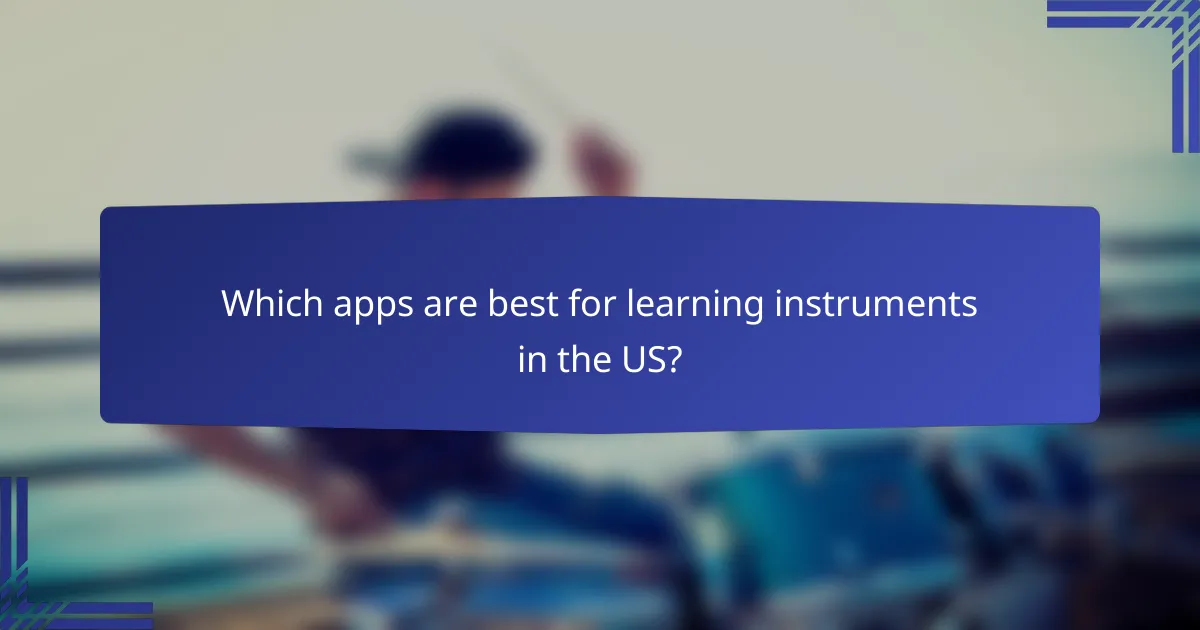
Which apps are best for learning instruments in the US?
The best apps for learning instruments in the US cater to various skill levels and musical interests. They offer interactive lessons, user-friendly interfaces, and compatibility with multiple devices, making them accessible for beginners and experienced players alike.
Yousician
Yousician is a popular app that provides interactive lessons for guitar, piano, bass, ukulele, and voice. It uses real-time feedback to help users improve their skills, making practice engaging and effective.
With a library of songs and exercises, Yousician adapts to your skill level, allowing you to progress at your own pace. The app is available on iOS, Android, and desktop platforms, ensuring compatibility across devices.
Simply Piano
Simply Piano is designed specifically for piano learners, offering a step-by-step approach to mastering the instrument. It features a wide range of songs, from classical to contemporary, catering to various musical tastes.
The app listens to your playing and provides instant feedback, helping you correct mistakes in real-time. Simply Piano is compatible with iOS and Android devices, making it easy to practice anywhere.
Fender Play
Fender Play focuses on guitar learning, offering lessons for electric, acoustic, and bass guitars. The app includes video tutorials and a diverse song library, making it suitable for beginners and intermediate players.
Fender Play emphasizes a structured learning path, allowing users to track their progress. It is available on both iOS and Android, ensuring accessibility for users across different platforms.
Guitar Tricks
Guitar Tricks is a comprehensive platform for guitarists, featuring thousands of video lessons across various genres. It offers a unique learning system that breaks down songs and techniques into manageable sections.
The app includes a free trial, allowing users to explore its extensive library before committing. Guitar Tricks is compatible with most devices, including iOS and Android, making it easy to learn on the go.
Flowkey
Flowkey is an innovative app for piano learners, combining video tutorials with sheet music. It caters to all skill levels and offers a wide selection of songs, from classical to pop.
Flowkey provides instant feedback on your playing, helping you improve quickly. The app is available on iOS, Android, and desktop, making it versatile for users who prefer different devices.
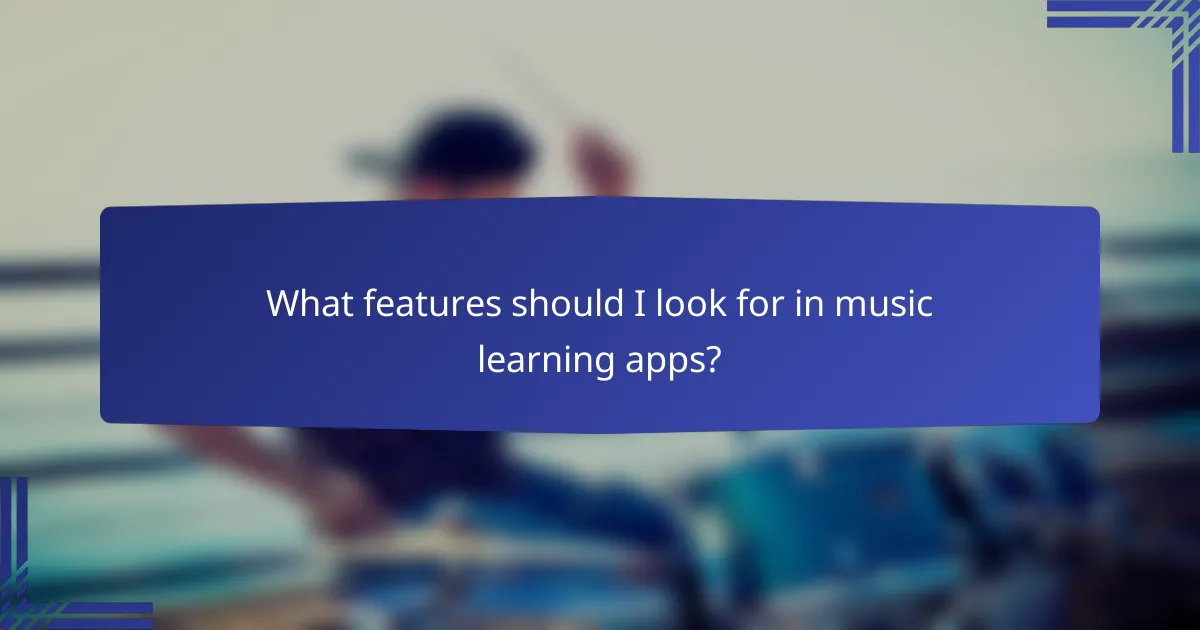
What features should I look for in music learning apps?
When choosing music learning apps, consider features that enhance your learning experience, such as interactive lessons, progress tracking, a diverse song library, and video tutorials. These elements can significantly impact your ability to learn and practice effectively.
Interactive lessons
Interactive lessons engage users through hands-on activities, making learning more effective. Look for apps that offer real-time feedback, allowing you to correct mistakes instantly. Features like gamification can also motivate you to practice regularly.
Examples of interactive lessons include playing along with backing tracks, completing rhythm exercises, or using touch-sensitive interfaces for instruments. Choose apps that adapt to your skill level, providing challenges that are neither too easy nor too difficult.
Progress tracking
Progress tracking features help you monitor your improvement over time. Apps that provide visual representations of your practice sessions, such as graphs or achievement badges, can keep you motivated. Look for options that allow you to set goals and milestones.
Some apps offer detailed analytics, showing how much time you spend practicing and which areas need improvement. This data can guide your practice sessions, ensuring you focus on skills that require more attention.
Song library
A diverse song library is essential for keeping your practice sessions enjoyable and relevant. Look for apps that offer a wide range of genres and difficulty levels, allowing you to explore music that interests you. The inclusion of popular songs can also enhance motivation.
Consider whether the app provides options to learn songs in various formats, such as sheet music, chord charts, or play-along tracks. A good song library should also be regularly updated to include new releases and trending hits.
Video tutorials
Video tutorials can enhance your learning by providing visual demonstrations of techniques and concepts. Look for apps that feature high-quality instructional videos from experienced musicians or educators. These tutorials can clarify complex topics that may be difficult to grasp through text alone.
Consider the length and format of the videos; shorter, focused clips may be more effective for quick learning sessions, while longer videos can provide in-depth instruction. Additionally, check if the app allows you to interact with the content, such as pausing or slowing down the playback for better understanding.
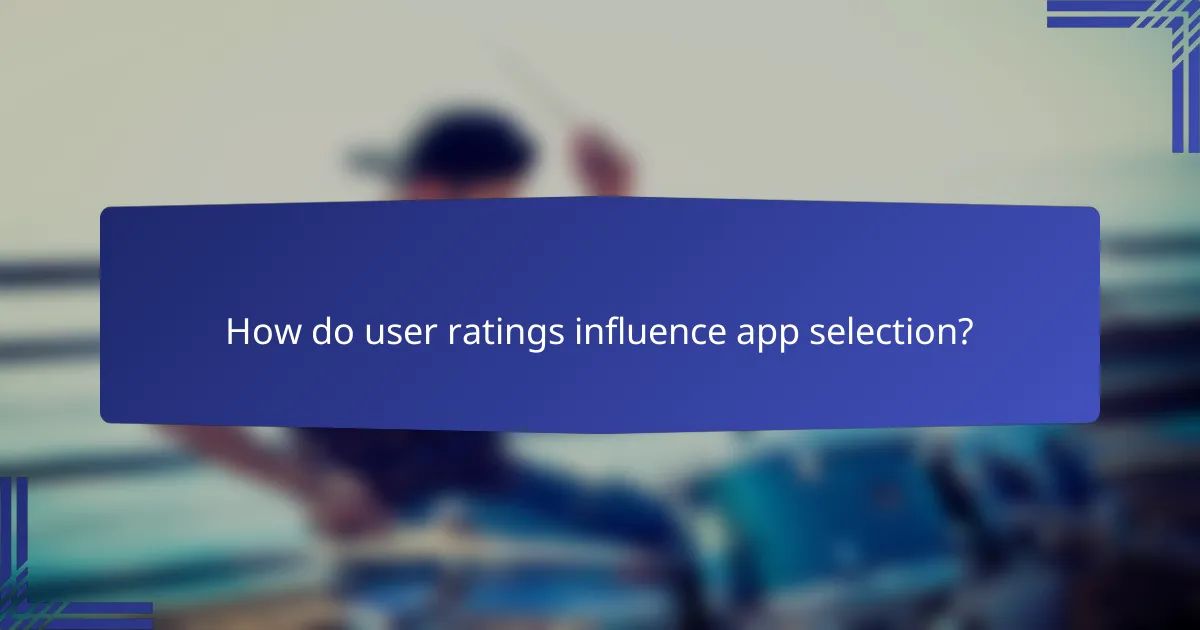
How do user ratings influence app selection?
User ratings play a crucial role in selecting music learning apps by reflecting overall user satisfaction and app quality. High ratings often indicate that an app meets user expectations, while the quantity and nature of reviews provide deeper insights into its features and usability.
High ratings indicate quality
Apps with high user ratings typically demonstrate quality in their design, functionality, and educational effectiveness. A rating of four stars or higher is often a good indicator that users find the app valuable for learning instruments. However, it’s essential to consider the number of ratings; an app with a high rating from a small number of users may not be as reliable as one with a slightly lower rating but thousands of reviews.
When evaluating apps, look for those consistently rated above four stars across multiple platforms. This consistency can suggest that the app is well-received by a broad audience, enhancing its credibility.
User reviews provide insights
User reviews offer detailed insights into the strengths and weaknesses of music learning apps. They often highlight specific features that users appreciate, such as interactive lessons, user-friendly interfaces, or effective practice tools. Conversely, reviews can also point out common issues, like bugs or a lack of content variety.
Pay attention to recurring themes in reviews. For example, if multiple users mention that an app’s lessons are engaging and easy to follow, it’s likely a strong choice. Conversely, if many reviews cite poor customer support or technical issues, it may be wise to consider alternatives.

What is the compatibility of these apps with devices?
The compatibility of music learning apps varies significantly across devices, affecting user experience and accessibility. Most popular apps are designed for iOS and Android platforms, with some also available on desktop systems, ensuring a broad range of options for learners.
iOS compatibility
Many music learning apps are optimized for iOS devices, including iPhones and iPads. Users can expect a seamless experience with features tailored to Apple’s operating system, such as touch gestures and integration with other Apple services.
When choosing an app, check the App Store for user ratings and reviews, as these can provide insights into the app’s performance on specific iOS versions. Popular apps like Yousician and Simply Piano are frequently updated to support the latest iOS releases.
Android compatibility
Android compatibility is also robust, with a wide selection of music learning apps available on the Google Play Store. However, performance may vary depending on the device’s manufacturer and operating system version.
Before downloading, verify that the app supports your specific Android version, as some features may be limited on older devices. Apps like Flowkey and GuitarTuna are well-rated for their functionality across various Android models.
Desktop availability
Desktop availability is an important consideration for users who prefer larger screens and more comprehensive features. Many apps offer web-based versions or downloadable software for Windows and macOS, enhancing the learning experience.
For example, platforms like Ultimate Guitar and Playground Sessions provide desktop access, allowing users to utilize additional tools and resources. Ensure your computer meets the app’s system requirements for optimal performance.
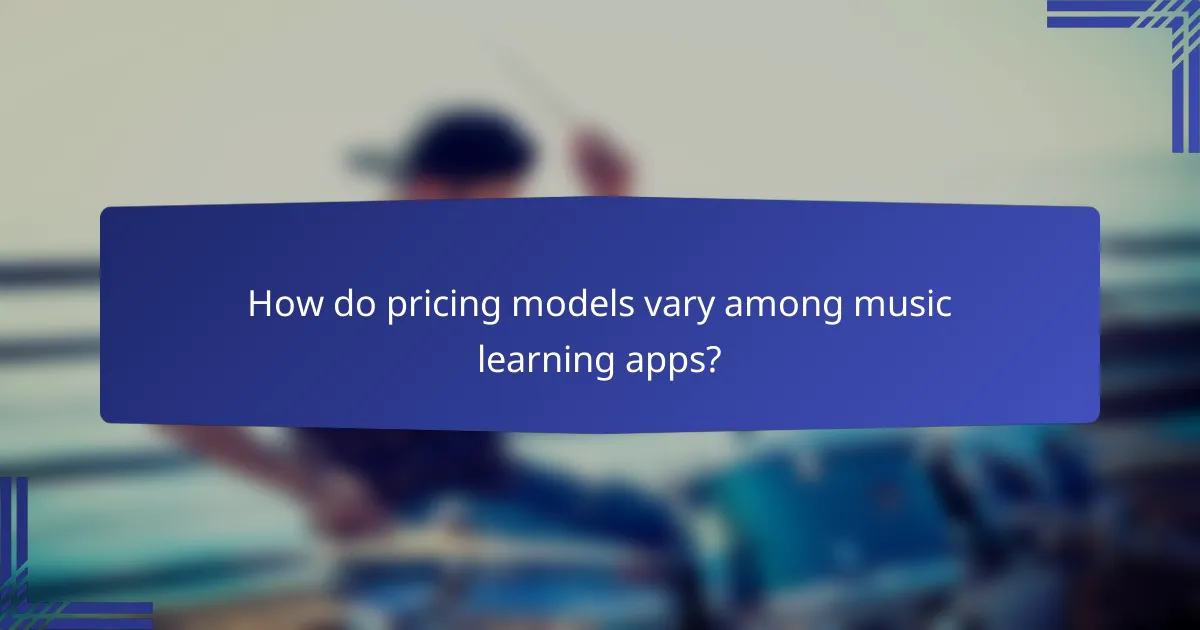
How do pricing models vary among music learning apps?
Pricing models for music learning apps can differ significantly, affecting accessibility and user commitment. Common models include subscription-based pricing, one-time purchases, and free trials, each with its own advantages and considerations.
Subscription-based pricing
Subscription-based pricing is prevalent among music learning apps, often charging users monthly or annually. This model typically provides access to a wider range of features, lessons, and updates, making it appealing for long-term learners.
However, users should consider the cumulative cost over time. For instance, a monthly fee of around $10 can add up to over $100 annually, which may be a significant investment for some. Always check if the subscription includes a money-back guarantee or cancellation policy.
One-time purchase options
One-time purchase options allow users to buy an app outright, providing lifetime access to its features without ongoing fees. This model can be cost-effective for those who prefer not to commit to recurring payments.
While one-time purchases often range from $20 to $100, they may lack the continuous updates and new content that subscription models offer. Users should evaluate whether the app will meet their long-term learning needs before making a purchase.
Free trial availability
Many music learning apps offer free trials, allowing users to explore features before committing financially. These trials typically last from a week to a month, providing a risk-free opportunity to assess the app’s effectiveness.
When using a free trial, be mindful of cancellation deadlines to avoid automatic charges. Take advantage of this period to explore different features and determine if the app aligns with your learning style and goals.
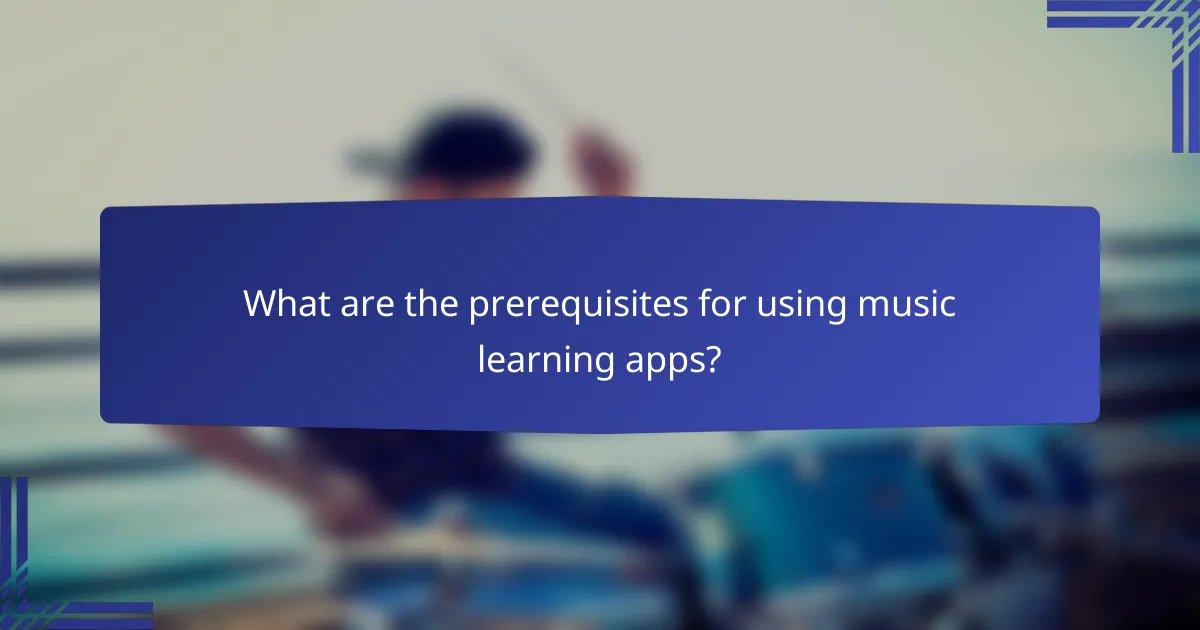
What are the prerequisites for using music learning apps?
To effectively use music learning apps, users should have a basic understanding of their chosen instrument and a compatible device. Familiarity with music theory can enhance the learning experience, though it is not strictly necessary.
Basic instrument knowledge
Having basic knowledge of your instrument is crucial for maximizing the benefits of music learning apps. This includes understanding its parts, how to hold it, and basic playing techniques. For example, knowing how to tune a guitar or position your fingers on a piano can significantly improve your practice sessions.
Apps often assume a certain level of familiarity with the instrument, so beginners may find it helpful to start with introductory lessons or tutorials. Many apps provide foundational lessons, but supplementing these with hands-on guidance from a teacher or instructional videos can be beneficial.
Consider setting realistic goals based on your current skill level. If you’re a complete beginner, aim to learn simple songs or scales before tackling more complex pieces. This incremental approach helps build confidence and keeps the learning process enjoyable.
